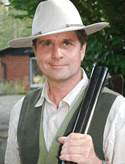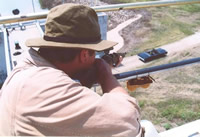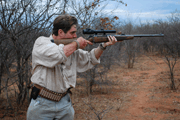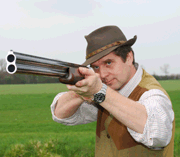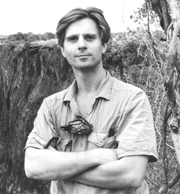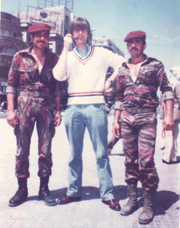THE SNOWS OF KILIMANJARO
To the man of spirit, my dear…opportunities are duties. – Rudolph Rassendyll in the Prisoner of Zenda.
If a member of the special forces of a foreign but friendly country phoned you up and told you that he needed a cameraman PDQ for an expedition to Kilimanjaro in a couple of weeks what would you say? Well, I said yes. It’s another chapter in my increasingly improbable life. I have always wanted to climb Kili and the prospect of doing it with a special forces team led by a sheik who happens to be an amusing companion and an excellent soldier was too good to resist.
Forgive me for being a bit cryptic in all this, I can’t tell you what country they were from – that would break a promise – I can tell you that they were Rangers and, on average, half my age (49 by the time you read this). The Sandhurst trained expedition leader was also a member of the Royal House of his country and had recently enjoyed some clay shooting with me in Essex (which is about as much of a shooting connection as I can come up with).
A lot of people climb Kilimanjaro these days. Do not make the mistake of thinking it is just a walk (though a great deal of walking is involved). About 10 people year die on the mountain (sometimes significantly more). One may climb the mountain by various routes, some are easier than others. Some routes – though they may require more immediate physical effort – acclimatise one to the altitude better than others. Altitude is the big issue with Kili, it is nearly 6,000metres high (5,895) – the highest point in Africa and the tallest free-standing mountain in the world.
 Before climbing it one needs to train and one needs to equip oneself with suitable kit. Before you get one with any of this, it is prudent to get a medical. I passed mine, though my blood pressure was a bit high and my weight was up too (six weeks later having climbed the mountain and lost nearly 2 stone, it had returned to an ideal 120 over 80!). I also asked my doctor for a prescription for Diamox (a drug which controls the symptoms of altitude sickness), for anti-malarial drugs (the area around Kili is extremely high risk) and for some broad spectrum antibiotics for emergencies.
Before climbing it one needs to train and one needs to equip oneself with suitable kit. Before you get one with any of this, it is prudent to get a medical. I passed mine, though my blood pressure was a bit high and my weight was up too (six weeks later having climbed the mountain and lost nearly 2 stone, it had returned to an ideal 120 over 80!). I also asked my doctor for a prescription for Diamox (a drug which controls the symptoms of altitude sickness), for anti-malarial drugs (the area around Kili is extremely high risk) and for some broad spectrum antibiotics for emergencies.
On the training front, I took things pretty easy. I used to be a runner, now I prefer speed marching or, to give it a trendy name, power-walking. I started with just half an hour a day (I was seriously unfit), moved to one hour after a week, and then to two (and more when I was in the mood) for the final two weeks before departure. I did a little bit of upper body training with light weights too. I trained for a month in all, not enough really, 8 weeks would have been much better. Nevertheless, my fitness and physique improved. As well as the marching, I ran up stairs whenever the opportunity arose, and got in habit of always taking stairs two at a time.
Retrospectively, I could have been fitter. But, I am nearly fifty (ouch!) and I did get to the top of the hill (which two members of climbing party did not). Most shooters of my acquaintance and age could probably do with starting a bit of gentle fitness training, the secret is not to overdo it. Moreover, if you can make it enjoyable so much the better – tennis, swimming, stalking as you will.
Back to Kili. The awesomely beautiful mountain – first climbed by Professor Hans Meyer, a German geologist in 1889 – stands just on the Tanzania side of the Tanzania-Kenya border on an otherwise pretty barren plateau. Kili and Mount Meru, another magnificent peak which is in view from Kili, are both extinct volcanoes. Infact Kili is made up of several extinct volcanoes and this geological drama is also associated with the creation of the Rift Valley a hundred or so clicks away.
The presence of two free-standing mountains in close proximity has some interesting environmental effects. An unusual ‘micro-climate’ is created. It increases the annual rainfall and causes the area between the two - which includes the towns of Moshi and Arusha – to be very fertile. Vegetation is lush and crops like bananas grow especially well. Close to Moshi – the town where one usually decamps for climbing expeditions – there are the famous Ngorongoro crater and the Serengetti plains – both of which teem with wild-life. From a tourism point of view, these are gold mines. I might also add that anyone who intends shooting plains or dangerous game in Africa would be well advised to start by photographing it first.
OK, let’s consider the practical stuff. There are more than half a dozen different routes up Kilimanjaro, Marangu, Shira and Machame are probably the most popular. Marangu is the easiest and also the most dangerous (more people get killed on it than any other because it attracts ill-prepared back-packers on a budget). Machame, the route we chose, is more difficult and requires greater fitness, but it also provides a better opportunity to acclimatise to the altitude. This is the great issue on Kili, most people will suffer to some degree from altitude sickness. One can take medication to reduce the effects of the symptoms (nausea, headaches, swelling) but few will escape the unpleasant condition altogether.
To minimise altitude sickness, one must keep well hydrated (4 litres a day), one must acclimatise (spending an extra day at altitude before attempting the peak will help a lot), one must pace oneself and one must never get cocky. Kilimanjaro may, literally, be a walk in a national park, but as noted it kills people who disrespect it each year in some significant number.
We spent 5 days walking and climbing up, and 2 days coming down. Things start of pretty softly as one ambles through the magnificent rain forest. The next day one moves on to moor land, then to alpine desert (a moonscape by the final day). Typically, each climber carries his own 25litre day pack and water, a team of porters carry tents and food and make camp before the climbers get to their watering hole for the night.
Sounds easy? It is relatively easy for the first couple of days provided one has no objection to trekking all day. Things become significantly more difficult though. Mostly, one walks. On Machame, there is a little technical climbing involved, though there is one precipitous and very narrow ledge which is not for the feint hearted and along which one must shuffle – carefully. Basically, it is a foreign legion, march or die job, one marches up and up and up.
By day three one is getting really tired. Most people report symptoms of mountain sickness and for some they may become severe. As far as I could gather about 80% of people make it to the top which means 20% don’t most as result of mountain sickeness. We carried oxygen, some cut price outfits don’t bother. Once you take oxygen though, you cannot proceed on up, one must – if one has any common sense – call it a day and return to lower altitude immediately.
Now, I do not want to exaggerate this, and it will affect different people in different ways, but I can say that climbing Kili by Machame was the toughest thing that I have ever done. The last day was a killer, the last hour and the arrival at Stella Point an adrenalin fuelled daze. One foot at a time. “I will make it.”. The feeling of satisfaction at the top. Extraordinary. Do it if you can, you will never forget it, but don’t think it is just a walk.


